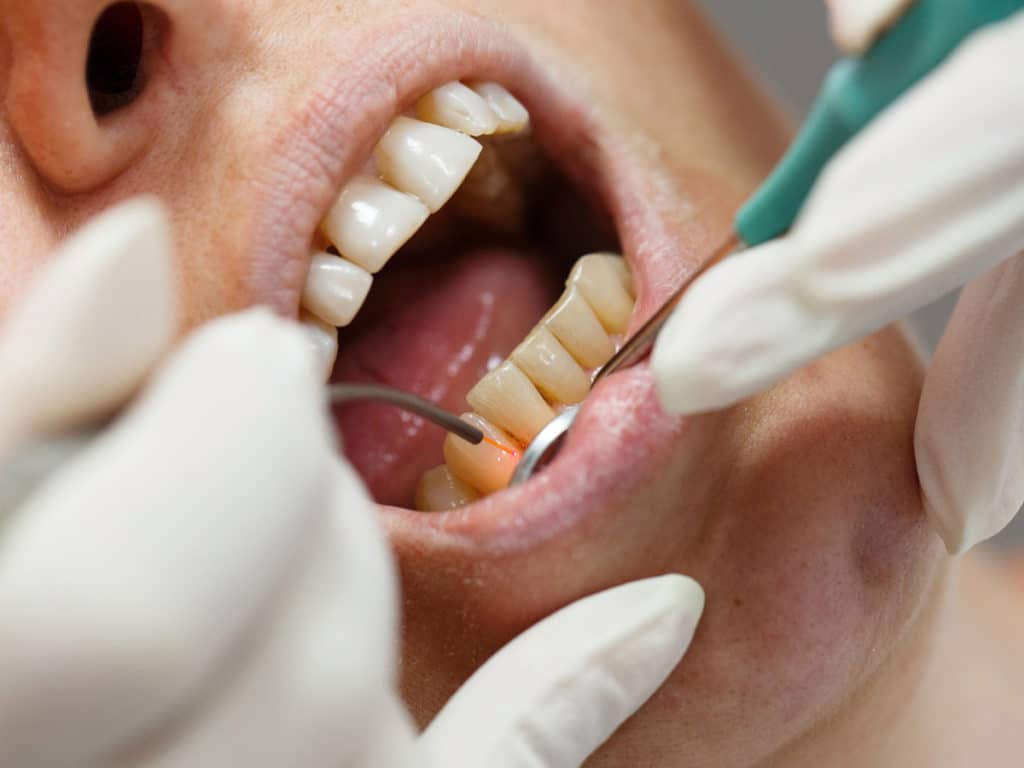
Gum disease isn’t a one-size-fits-all condition. There are different stages of gum disease and different treatment options for them. Usually, the sooner your periodontal disease is diagnosed and treated, the less involved treatment needs to be, and healthy gum tissue can grow.
There can be severe consequences from periodontal diseases, such as loose teeth and bone loss. It is essential to watch out for the warning signs of gum disease, like sensitive teeth, swollen or bright red gums, receding gums, halitosis (bad breath), and bleeding when brushing or flossing.
Some people might see significant improvement after deep cleaning their teeth and gums, while others might need more invasive procedures to restore the gums and remove the bacteria and plaque.
What is Gum Disease?
Also known as periodontal disease, gum disease is an infection affecting the gingival tissues that surround and support your teeth, primarily caused by plaque-induced gingivitis, which is a sticky film of bacteria that forms on the teeth. If plaque is not removed through daily brushing and flossing, it can harden into tartar, which can only be removed by a dental professional.
Identifying the Type of Gum Disease You Have
Gingivitis and periodontitis are the two main types of gum disease. Gingivitis is the mildest form of gum disease and is characterized by inflammation of the gums (gingival tissues), which can cause them to become red, swollen, and bleed easily. Gingivitis is typically caused by poor oral hygiene and can often be reversed with proper dental care. When the early form of periodontal disease progresses (untreated gingivitis), it can damage the gums, bone, and other supporting structures of the teeth, eventually leading to tooth loss.
Periodontitis, which is a more advanced form of gum disease, occurs when the infection spreads beyond the gum line and starts affecting the bone and other supporting structures of the teeth. If left untreated, periodontitis can lead to other serious health complications.
Identify the Stage of Gum Disease
Gum disease is classified into four stages, ranging from mild to severe. The extent of damage to the gums, bone, and other supporting structures of the teeth determines the stage of gum disease:
- Gingivitis: The earliest stage of gum disease, characterized by inflammation and bleeding of the gums.
- Early periodontitis: A stage in which the infection has spread beyond the gum line, beginning to affect the supporting structures of the teeth, including the bone.
- Moderate periodontitis: The infection has caused significant damage to the bone and supporting structures, leading to increased tooth mobility and potential tooth loss.
- Advanced periodontitis: Severe damage to the bone and supporting structures, resulting in tooth loss and other serious health complications.
In the most advanced cases of gum disease, the bone of the teeth is affected. If left unchecked, the bacteria and inflammation can destroy the bone, leading to tooth loss. A bone graft surgery can involve using a patient’s tissue to restore the damaged bone or using a special tissue-stimulating material to replace it. At this stage, periodontists often recommend options for patients with bone loss such as grafting or regenerative therapies.
Is Gum Disease Reversible
Gingivitis, the earliest stage of gum disease, is often reversible with proper dental care, including regular brushing, flossing, and professional cleanings. As the disease advances to periodontitis, the damage to the bone and other supporting structures of the teeth may become irreversible. The appropriate treatment of periodontal disease depends on the stage of the disease.
Surgical Gum Disease Treatment
If non-surgical gum disease treatments Miami aren’t sufficient to fully treat periodontal disease, or if pockets and inflammation remain after non-surgical treatment, a periodontist might move on to surgical options. There are numerous surgical techniques available for treating periodontal disease.
Advanced periodontal disease can cause the gingival, or gum, tissue to pull or recede away from the teeth. It can also destroy the bone of the teeth. In those cases, either gum grafting or bone grafting might be required.
Flap Surgery
If root planing and deep cleaning didn’t reduce the pocket depth around the teeth, flap surgery might be the next step. This surgery involves cutting away and lifting the gums, then removing built-up tartar. The periodontist then eliminates or significantly reduces the size of the periodontal pockets by repositioning the gums around the teeth.
AlloDerm Dental
Newer developments, such as AlloDerm, eliminate the need for a graft to be taken from the palate or roof. Alloderm dental uses grafts produced from human tissue, but not taken directly from the patient. This gum disease treatment eliminates the need to surgically remove tissue from one area, making it a more comfortable and less involved treatment option for patients.
Innovative Gum Disease Treatment
Gum disease treatment in Miami, FL has evolved over the years, and many options available now use state-of-the-art technology to restore lost tissue or otherwise correct the disease.
Pinhole Surgical Technique
One example is the pinhole surgical technique, which corrects gingival recession without needing a completed surgical procedure or gum graft. During the pinhole procedure, the periodontist makes several small holes in the gum line. The gum tissue’s position can be adjusted through these small pinholes so that the roots of the teeth are covered by the formerly receding gums. This treatment has less recovery time and is more comfortable than traditional gum grafting.
It is ideal for any patient with gum recession to schedule a consultation with a periodontist to evaluate periodontal health.
LANAP Surgery
Another advanced technique for periodontal disease treatment involves the use of lasers. LANAP (Laser-Assisted New Attachment Procedure) is ideal for many types of patients, including those with diabetes and other long-term conditions who might not be good candidates for traditional periodontal surgery. It’s less invasive and more comfortable, as well.
This revolutionary treatment for gum disease in Miami, FL uses lasers to remove diseased periodontal tissues and harmful bacteria from around the tooth roots. LANAP also stimulates tissue regeneration, helping to restore the gums and protect against further damage.
Laser gum surgery deep also cleans the teeth and gums, reattaches loose tissue, and stimulates the production and growth of gum tissue. LANAP also has a shorter recovery time and might require fewer office visits.

Non-Surgical Gum Disease Treatment
Healthy tissue can be encouraged to grow back with the help of dental professionals. A healthy mouth is important for overall health, and periodontal disease treatment should be tailored to each individual’s needs. Fortunately, there are a few non-surgical treatments for periodontal disease Miami designed for different patients.

Dental Cleaning
If you have very early-stage gum disease, known as gingivitis, a cleaning from your dentist might be sufficient to treat the issue. At your dental appointment, the dentist will clean your teeth and remove tartar and plaque that has built up around the gum line.
After the professional cleaning, it’s usually recommended that you maintain a good dental hygiene routine at home, brushing and flossing daily. If you have gingivitis that seems to occur regularly, your dentist might recommend coming in for regular cleanings more than twice a year to prevent the condition from moving toward more advanced gum disease.
Scaling and root planing
If your gum disease has advanced past gingivitis, nonsurgical treatment might still be an option. More advanced stages of periodontal disease can often be treated with a deeper cleaning known as scaling and root planing. The periodontist removes built-up tartar by cleaning the teeth above and below the gum line during the treatment.
If root planing is involved, the periodontist will file the roots of the teeth so that they are smooth. Smoothing the root surfaces gives oral bacteria fewer places to hide or collect, making them less likely to build up on the teeth and gums.
Along with removing plaque and tartar and planing the roots, nonsurgical periodontal disease treatment might also involve an antibiotic medication to kill off any lingering bacterial growth. Your periodontist might prescribe an oral antibiotic, an antibacterial rinse, or place a dissolving gel or chip between the gum and the tooth. The chip or gel melts away over time, releasing an antibiotic as it does so.
Prevention and Maintenance Strategies to Keep Your Gums Healthy
Maintaining good oral hygiene is crucial for preventing gum disease and maintaining healthy gums. Here are some strategies to keep your gums healthy:
- Brush your teeth at least twice a day, using a soft-bristled toothbrush and fluoride toothpaste.
- Floss daily to remove food particles and plaque from underneath the gum line and between your teeth.
- Use an antimicrobial mouthwash to help reduce plaque and bacteria in your mouth.
- Avoid smoking and tobacco products, as they can increase your risk of gum disease.
- Maintain a healthy diet, rich in vitamins and minerals, to support your overall oral health.
- Visit your dentist regularly for checkups and professional cleanings to help detect and treat gum disease early.
Frequently Asked Questions about Gum Disease Treatment
What is the best treatment for gum disease?
The best treatment for gum disease may differ between patients depending on the type, stage, and severity of the disease, as well as the patient’s overall health and preferences. Non-surgical treatments like dental cleaning, scaling, and root planing may be sufficient for early-stage gum disease. For more advanced cases, surgical dental surgery such as flap surgery, AlloDerm dental, pinhole surgical technique, or LANAP surgery may be necessary. Consult with a dental professional to determine the most appropriate treatment for your specific situation.
What is the best antibiotic gel for gum infection?
Antibiotic gels or medications may be prescribed by your dentist to help control gum infection and promote healing. The type of bacteria causing the infection and the patient’s medical history will determine the specific antibiotic used. Commonly used antibiotic gels for gum infections include Arestin (minocycline), PerioChip (chlorhexidine), and Atridox (doxycycline).
Is periodontal gum treatment painful?
The level of discomfort experienced during periodontal gum treatment varies depending on the type of treatment and the patient’s individual pain tolerance. Non-surgical treatments like dental cleaning and scaling and root planing may cause minor discomfort but are generally well-tolerated. For surgical treatments, local anesthesia is typically used to numb the area and minimize pain during the procedure. Post-operative pain can be managed with over-the-counter pain relievers or prescribed medications, as recommended by your dentist.
How do I stop periodontitis?
Stopping periodontitis requires a combination of professional dental treatment and diligent at-home oral care. Here are some steps to help stop periodontitis:
- Seek professional dental treatment to address the infection and remove dental plaque and tartar buildup.
- Maintain good oral hygiene with good daily cleaning habits, such as brushing and flossing daily, and using an antimicrobial mouthwash.
- Prioritize appointments for dental checkups and professional cleanings.
- Adopt a healthy lifestyle, including a balanced diet and avoiding tobacco products.
- Manage any underlying health conditions, such as diabetes, that may contribute to gum disease.
By following these steps and working closely with your dental healthcare provider, you can effectively stop periodontitis and maintain healthy gums.
Schedule an appointment with us!
The first step to treating your periodontal disease is getting an accurate diagnosis. At Gallardo Periodontics, we are experts in dental health, and we will discuss your periodontal treatment options. Weighing the pros and cons of each treatment and knowing what’s involved in each can help you make the most informed decision. Contact us today to schedule an appointment and start your journey to a healthier smile.